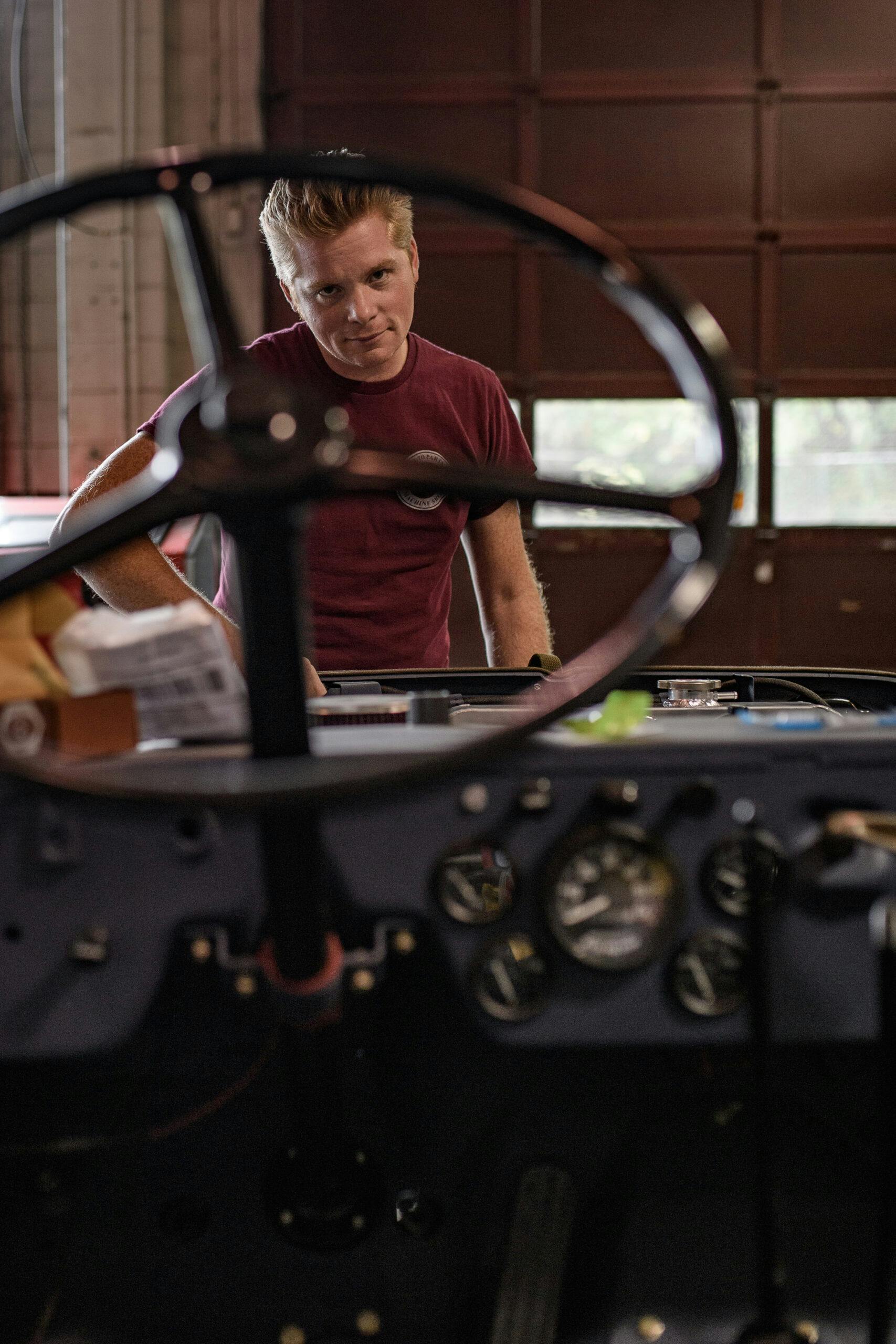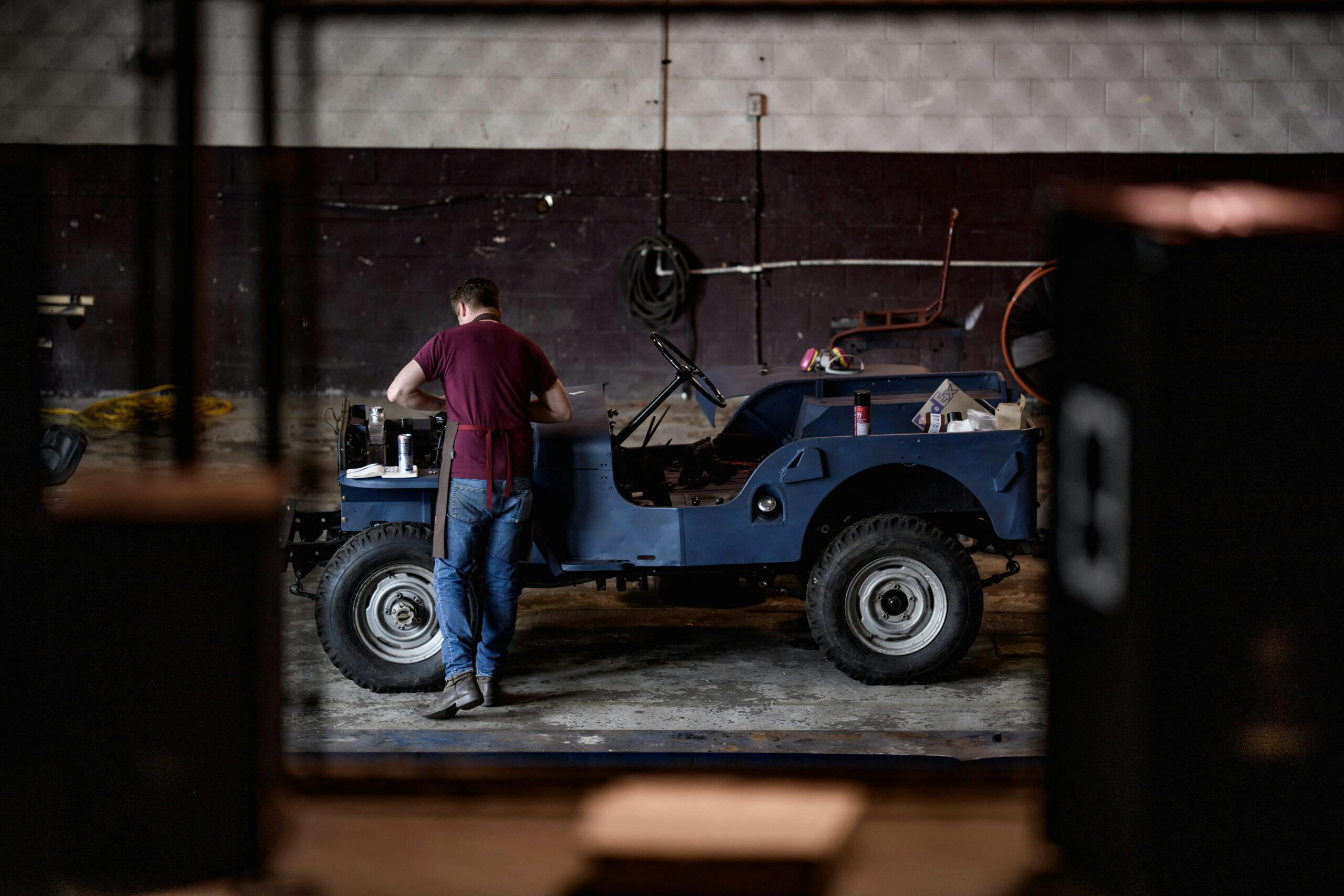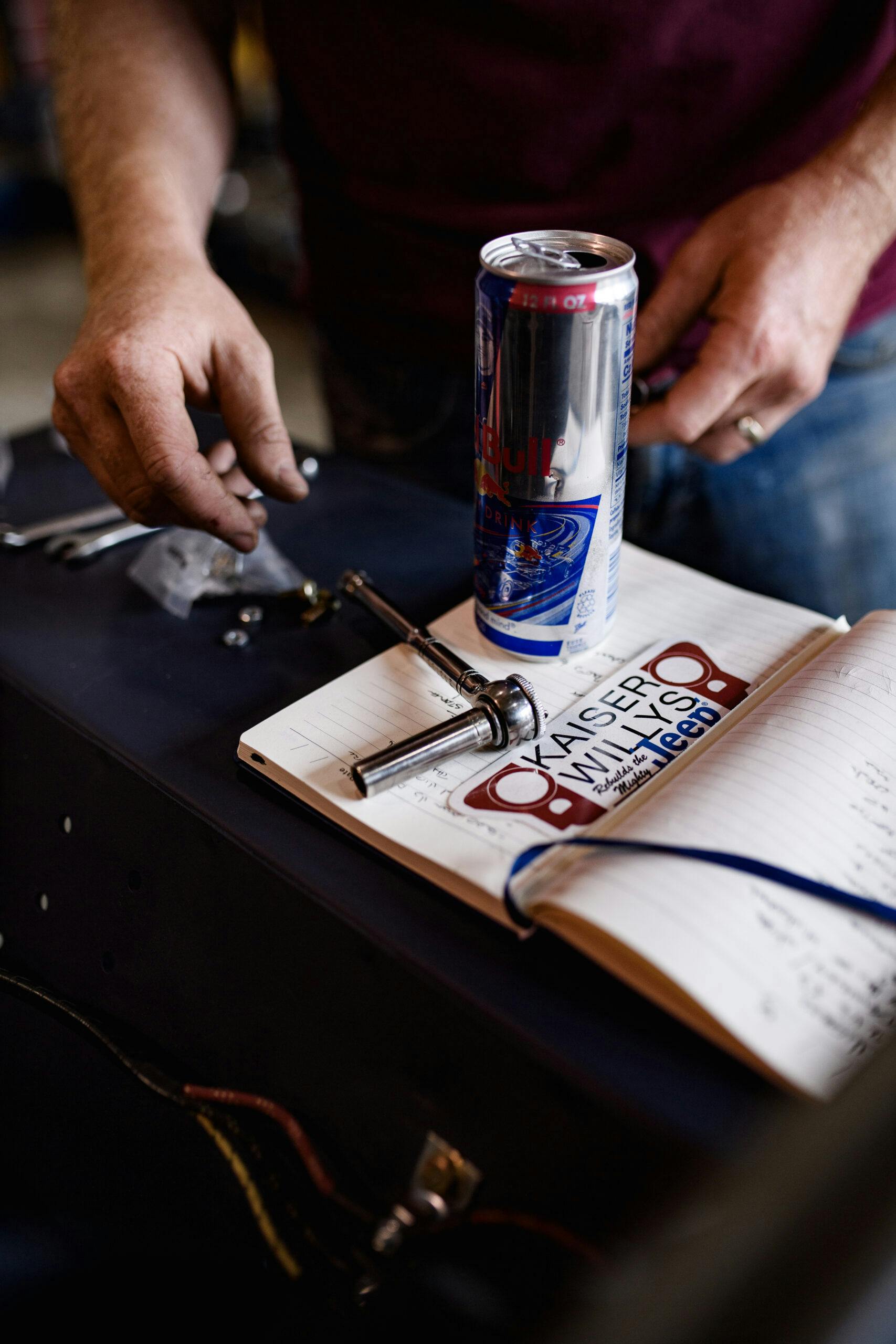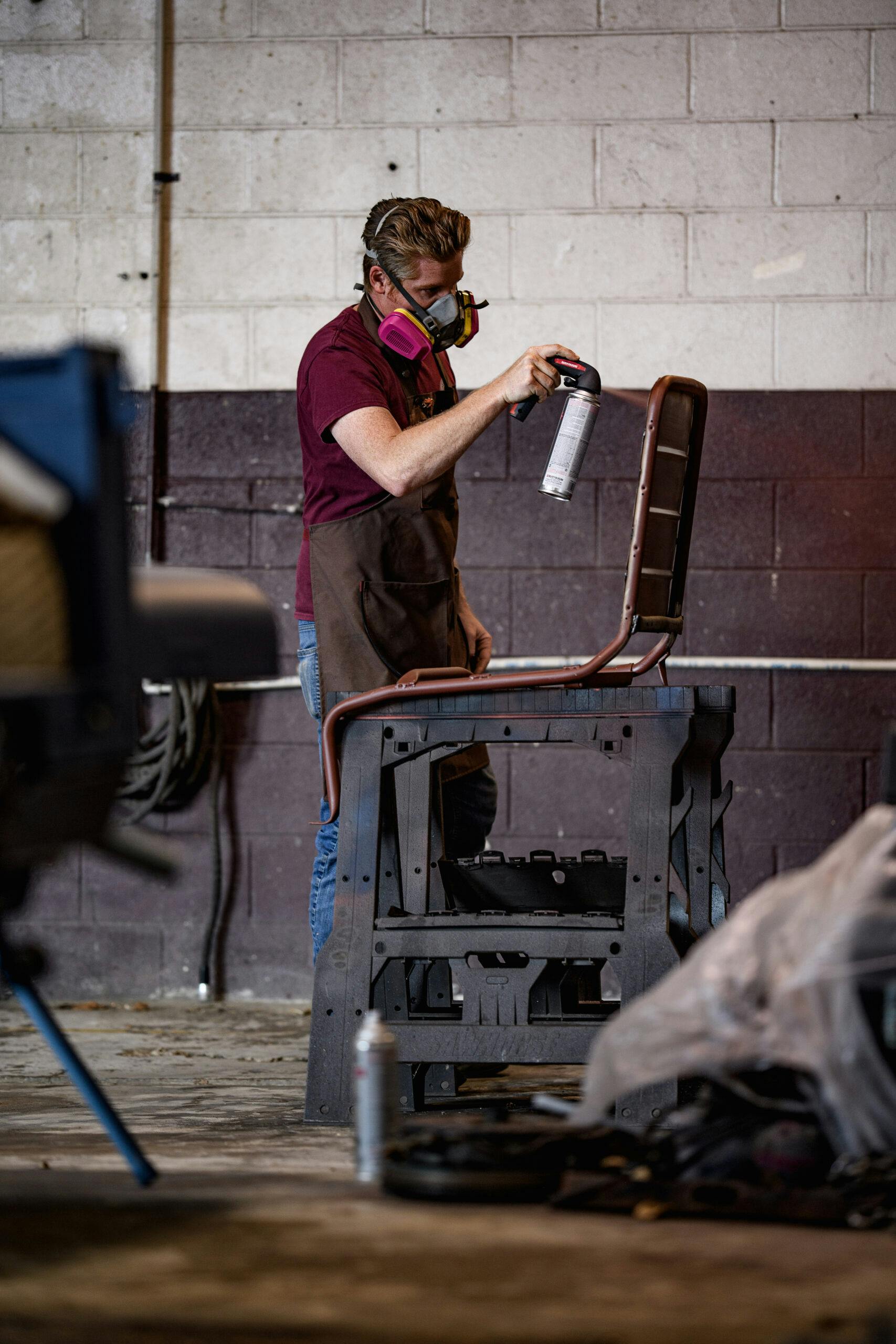Climbing Out of the Doldrums: What to Do with a Stalled Project
This article first appeared in Hagerty Drivers Club magazine. Join the club to receive our award-winning magazine and enjoy insider access to automotive events, discounts, roadside assistance, and more.
After more than a year of nursing my ‘48 Willys CJ-2A back from the edge of the scrap pile, I decided it was time to check the valves. Maybe look into finally addressing the worn steering gear. Both exercises require pulling the driver’s fender, which came away with no more than the usual handful of broken bolts. With the sheetmetal gone, I was treated to the first clear view of the little Jeep’s frame. More specifically, I could see the terrifying number of cracks around the front crossmember and the previous owner’s attempts to booger weld the thing back together. Determined to right these wrongs, I removed the bumper, which revealed one frame horn that sat 3 inches higher than the other. A smart man would have bolted everything back together and went on his way, enjoying the bright, warm Jeep months of spring and summer. I am not a smart man.
***
I bought a frame and tub—then two more when the first pair turned out to be more work than I bargained for—and tumbled headlong into my first frame-off rebuild. I say “rebuild” instead of “restoration” because I had neither the funds nor the inclination to wind up with a glossy, better than perfect re-creation of what I had. I wanted a truck that showed its bumps and bruises, that I wouldn’t mind firing at a fire road or the local off-road park. Something that could sit outside during a camping trip thunderstorm without giving me palpitations.
But soon enough, the old While You’re In There demon showed up. I wound up sandblasting and painting the frame, buying new springs, cleaning up the axles, and pulling the cylinder head. I rebuilt the transmission and bought an overdrive. Patched and painted the tub. After a few months, I looked up and found myself far from shore on a vehicle that once brought me nothing but joy. Every time I turned around, it asked for another couple hundred dollars worth of parts, none of which seemed to edge me any closer to bopping around downtown Knoxville or cruising under the hardwood canopy of the Nantahala National Forest.




Work on machines long enough and you’ll find yourself here: The Doldrums. Becalmed by your own decisions and the seemingly endless amount of work left before you can turn the key. The thought of sanding one more panel, turning one more bolt, or welding one more stitch is enough to make you scream. Your eyes wander. Your search history becomes full of other potential projects. Or worse, you grow to hate the thing. What was once a bright spot in your life becomes a pit of loathing. It transforms itself into a shelf in the garage, a convenient place for holiday decorations and your own despair.
For ancient sailors abandoned by the winds that carried them along, the only solution was to wait for their sails to fill again, but that’s a gambit on a project. The longer you stay away from the wrenches, the larger the tasks facing you loom. The work seems to swell with each day. Soon enough, the project takes on a kind of menace. Days become weeks, weeks turn into years, and eventually your heirs sell your parts for pennies.

So what do you do about it? How do you find motivation when it has no interest in finding you? That’s a question that goes far beyond worn bearings and rusted fenders. So many of us find ourselves bent over a mechanical question because of the simplicity of the thing. There is a black-and-white answer to why a plug won’t fire or an engine won’t turn. In a world increasingly devoid of such luxurious simplicity, solving those riddles can be a balm, but motivation has nothing to do with metal. It’s anchored in the gray matter between your ears.
***
Writers aren’t strangers to this problem. Novelist Anne Lamott, in her excellent Bird by Bird: Some Instructions on Writing and Life, shares her tactics for squaring off against daunting tasks. For her, that’s writing a book, but putting a vehicle together isn’t so different. In it, she shares her father’s advice for a distraught child who put off a report on local birds until the night before it was due: Take it bird by bird. In other words, don’t look at the pile of parts before you as a whole. Break it out into smaller, more manageable tasks. Don’t fret about the body work. Focus on one fender. Cross it off the list and move on.






But whatever you do, keep moving. There’s a reason we call it working on cars. It’s work, and work isn’t always a holiday. As I’ve dragged myself through the various stages of grief, I’ve come to rely on the almighty List to help me cover ground. It’s no good trying to keep it all straight in my head. I’m likely to start on a wheel bearing and wind up trying to solve that pesky radiator mount with the front hub still disassembled. I have to write the thing out, usually on a scrap of cardboard. I sketch out 10 manageable tasks and go from there. I’m not alone. Billionaire Warren Buffet famously gets through his day by making two lists. The first contains 25 goals. He reportedly circles five of the most important and scraps the remaining 20. Those five items become his actual to-do list, and he avoids the leftovers like the plague. I’m not sure if that sort of dogged prioritization will get me closer to becoming a billionaire, but it has helped me work on an old Willys.

There are ways to make the effort a little sweeter. Stuck waiting for other parts, I ordered new gauges for the 2A to replace the cobbled-together mess that came with the Jeep originally. There weren’t even axles under the frame at the time, and most of the transmission was still spread out over the workbench. But I installed the gauges as soon as they arrived anyhow. Seeing those gleaming faces against the fresh matte blue paint gave me a nudge to go ahead and finish the wiring. For the first time in months, I could see why I started down this path. I could imagine bopping along a mountain stream, the air slick with the smell of trout, the gauges reflecting the forest above. Just like that, the tub was ready to go onto the new frame. Over the next week, I finished the transmission and wrestled the axles in place. Then I bought some beer, called a couple of buddies, and we married the two halves of the old Willys.
That’s not to say I’m done. I’m slogging through the last of the body work now, filling holes and cutting out rust. The internet’s full of freshly stamped metal, but the budget ran dry back in July, and I’ve come to appreciate the dings this machine wears. This vehicle is nearing 100 years old, and by the time I’m done, it will be ready for another 100. It’s earned the right to wear its scars.


It’s been a grind—and not at all why my wife, Beth, and I brought the 2A home all those months ago. But it is satisfying seeing the Willys sitting in the shop, wearing its fenders and a grille. I can feel that spark of excitement again, same as the day I put Beth in the passenger seat for the first time. We went sailing down a country lane with only the faintest suggestion of brakes, the Go Devil four-cylinder happily churning along ahead of us. The world sang by with a backup track of our laughs and the whine of straight-cut gears.
For some of us, the work is the point, but for me, those moments are why I spend my spare seconds up to my elbows in the bowels of one machine or another. They make the split knuckles and barren checking account worth it. That was hard to remember when I spent my summer sandblasting and welding, sanding and painting, rebuilding and assembling. But seeing that upright grille in place makes it clear again. Of all the joys this world offers, none are equal to those of an old machine.

***
Check out the Hagerty Media homepage so you don’t miss a single story, or better yet, bookmark it. To get our best stories delivered right to your inbox, subscribe to our newsletters.



I have seen so many questions on the forum I belong to that are simple questions. Most are common questions of reason. Many are because they don’t have the right tool. Simple ones like what oil should I use! Check the forum past post in a search box. I fear that these projects are doomed to failure. Many didn’t check for rust and were surprised. A service manual can help a lot. Also many don’t have the skills and wish they did. Me if I couldn’t do it I have a specialty shop nearby and had them do it.
I envy the workspace that this gentleman has to work in! It’s a bit daunting when your workspace is 20′ x 20′ filled with a 60gal vertical compressor, a rolling plate mounted 2’x4′ vacuum system, 6″ jointer, 18″ surface planer, 3’x18′ bench with radial saw imbedded, laundry sink, 3’x 18″ cabinet and lastly the 2’x3′ rollaway tool cabinet. All of this other than the compressor on wheels. In addition to a big Healey in the mix as well. Need to work up the nerve to empty out the needed stuff to the carport, after clearing it, before even beginning to work.
Wind up getting tired out just getting ready to work! Viewing Zach’s workplace makes me very envious!
too many hobbies?
Lists They are a good thing I remember years back after my father retired he would sit down at the kitchen table every morning and with his coffee he would make a list of things that needed to be done that day . My mother would always come by hand him a list of things that she wanted done, he would put the two list’s side by side and any of her items that were also on his list he would do first. He would get up to leave and put her list in the cook stove and then go about his day with list in hand.
is the article by zach or camden? cudos to the responsible journalist(s). and a lot of good info in the comments section, thanx.
where the novelist’s father’s comment is mentioned about ‘take it bird by bird’, my father told of a similar parable/analogy: how do you eat an elephant? the answer being ‘one bite at a time’. when looking at a project as a whole, before or after getting into it, it might appear be daunting, overwhelming – HUGE. but breaking down to just one bite, or task, at a time, it starts to become a realistic possibility. it’s the same with any big project. a few years ago, a big tree in my back yard fell. thinking the cleanup will be a long laborious task, i debated calling in a tree service or doing the work myself. i decided the latter, got a really nice 40v 18″ chain saw, and went at it a step at a time. got it done in about 1 1/2 weeks, working 1-2 hours at a time. once completed, it reminded me of the satisfaction i get when doing a job myself. and now i have a good chain saw, and for a lot less than the cost of hiring someone. with the direction the journalist is now taking, his jeep will still only get done when it’s done. but he won’t be thinking it to be the chore he thought it was going to be at one point. as a bonus, here’s a quote that’s helped me in different ways: ‘there is nothing either good or bad, but thinking make it so’ – william shakespeare
this article has a lot of direct & indirect answers. a lot of us will respond to them differently, hopefully one or more will ‘hit home’ and get us going again, and enjoying the work.
I changed the wording around from Kevin Costner Movie. If you build it they will come to If you work on it it will get done.
I guess the best way to avoid getting at the point of a stalled project is to be realistic on what you can and are willing to do as well as invest. We all love to watch the shows where 18 folks with professional skills do a complete resto in 2 weeks in their state of the art facilities on the rusty 69 Dodge Charger with unlimited capital. The majority of the rest of us don’t have anywhere near that situation. Restorations almost always, cost more, need more and take more time than planned. I agree with the comment on the workspace shown though being in Florida I would hate to try/afford to keep that place cool enough to work in.
Sometimes, you have to throw the towel in. I have taken my car as far as I want to. The battery was 5 years old and it was very doubtful that I could get a 6 volt jump if the car would not start. The starter motor wold turn fine for a few seconds and then bog down. Installed a new battery, cleaned up all the connections and it spun the starter vigorously, however, the engine would not fire. Checked more connections, checked the fuses, and discovered some weird voltage readings. Put in a newer ignition switch in with no change. My son-in-law and myself were convinced it had to be something simple that we were missing. Ok, I,m a patient person, however, I did not want to start throwing parts at it. I followed the AAA tow truck to the local dealership and tried to explain what was going on. In other words, I threw the towel in and cried “uncle”. First thing they discovered was the new battery was no good and would not hold a charge. I should have checked that. A new 6 volt battery is going to sit on a shelf for a long time. Very little demand here. New replacement battery and the car still would not start. It turns out that it was a fuel line. I replace the fuel line 14 years ago. Just about the time that ethanol was added to gasoline. The fuel line was not ethanol resistant and gas was weeping out the swollen line. There wasn’t enough gas reaching the engine anymore to start it. It was just coincidence that the fuel line decided to become dysfunctional on the same day I decided to get a new battery. Giving up on a needed repair may not be in a car guy’s DNA, however, there are times when you have to.
Message was magical to me…brought enthusiasm to my heart. Recovering from “minor” stroke…time to get back at it.
Is the small things…
Good article, good comments. Be realistic about what you can do. I’m lucky, I retired (18 yrs now) and I have a local University that has automotive programs, mechanical, body, paint, etc and I can leave a car there for both semesters and work on it all school year. So I can dedicate myself to the work, and lists are essential to getting the job done. Built 2 cars (‘28 Model A hot rod and ‘54 Studebaker, LS powered, 6 speed, narrowed 9”, suspension upgrades, body work, paint, upholstery – had to do that 3 times before I figured it out). I’ve also painted some cars, done collision repair (sell your Audi, don’t repair it, gotta be the hardest car to work on, ha, ha).
So, 14 years in school, still a freshman.
Be sensible, plan and make lists. And have fun.
I’m thinking of doing just that! Aims community college has a great program in Colorado.
I have a 40 x 72 shop but not the skills yet.
I’m stalled on a project now! 61 Rambler convertible. Solid, top mechanism works, have new interior (except carpet), original engine and trans runs. Rebuilt the front suspension, but got side tracked on a disc brake conversion using Honda Accord calipers and rotors. Selling the brackets to other AMC owners who want to convert. The bracket project took a while! Was going to use air springs, but a friend advised that they aren’t the best ride, so I’ve decided to put the original springs back in. Will order stiffer springs for improved handling later, I just want to get the thing moving! Doing an engine swap. Bought a 2003 Ranger 2.3L Duratec/five speed auto. Have to change rear axle gear to run that. Might just put the original springs back in and drive it some with the running (just needs a little carb work, maybe new carb) original engine and three speed auto, but then I have to do the interior. Wife says just wait until engine swap, but that’s going to take some time! I’ve got to get back on it, want to have it ready to drive for next year’s AMO National show (AMO is the national AMC club) in Greenville, SC, only a couple hours away! Would like to take it to Kenosha next year, but that might be pushing it! Got to get back on it this fall….
I bought a hot rod body and frame in 1991. Just got it on the road last year. Had it about halfway done and put it on eBay about 10-15 years ago. No luck selling. Plucked away at it. Money and time were always an issue. Over the years built a house mostly by myself and put a kid thru college. Life got in the way. The hotrod always got the short end of the straw but somehow I persevered It was a long road to the finish line
I especially loved the very wise comments of ” Patrician” with his great advice about old cars :
“spend your time driving it instead of fixing it”.
The list idea has worked for me beautifully. On number 6 frame off restoration. When the project doldrums start, I use the large tablet style list so that I can look back at what has been accomplished. Sometimes I don’t get back to work on things for weeks or months. The list helps me keep track of where I was plus look forward to see what hard to find parts I should be ordering. We all know the excitement achieved when you start down the home stretch and the vehicle will be complete, a subjective term 😊 Anything that can be used to keep things organized and provide motivation is worth a try.
A good reason to have multiple classics. Start with a good working example. Something to go out in and enjoy even if it’s not perfect. And a project vehicle to keep you involved in the hobby. Iam not so sure getting to the finish line is worth it sometimes. Having an unfinished project for a decade or two I think has become a right of passage. There’s something about a pile of parts….
Excellent article !
I was waiting for him to get to saying – make a list …
Having restored a Lotus Cortina, Jaguar E-type, and Morris Cooper S in the last 10 years, I am currently doing some major mechanical work on my Austin Healey 3000. You cannot afford the distraction of ending up in a funk over a major part of the job ending up stalling you.
On the wall just above my wash hand basin in the shop is a fairly large white board.
It is divided into 3 sections. On the left is a sequenced list of various project cars I need to work on, on the right is a column of all my cars, and notes for each on the last date of service or repair with a brief description.
But the large center column is a list in order of priority of each step in a process of restoring the car.
Whenever I wash my hands, I can stare at the list, and it focuses me on what the current priority is and helps me look forward to the next step.
Now some items in the list take months, and others are quick and simple but important – for example, “weld in repairs to body” or “prime, fill and flat body” take months, versus “restore carburetors” or “rebuild instrument panel”.
So when one of the more lengthy tasks runs up a creak, rather than getting in a funk, I pick a simpler task that is not dependent on a previous step, such as “rebuild carburetors”, and do that for a while.
This gets my mind off the annoying major task I ran into a problem with, and while I’m busy with the minor task the solution to progressing on the major task is formulated, and I become motivated to get back to the major job again.
And yes, there is nothing like crossing off a key step in the list when complete.